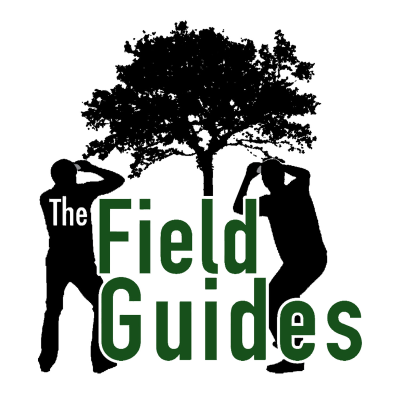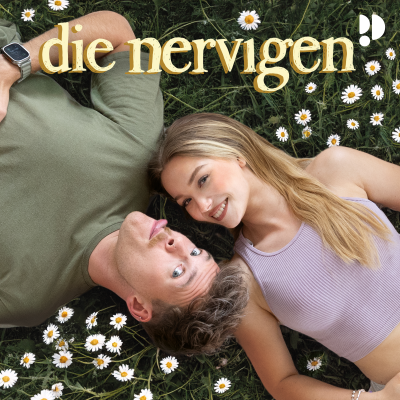
The Field Guides
Podcast von The Field Guides
Nature nerds rejoice! The Field Guides is a monthly podcast that will bring you out on the trail, focusing on the science of our North American wildlife.
Nimm diesen Podcast mit
Alle Folgen
90 FolgenBill and Steve look into the Dawn Chrous, that early morning explosion of bird song that refuses to let you sleep in. And, for all you Daniel-haters out there, this episode is 100% Daniel-free (but Bill and Steve are both crying on the inside. We miss Daniel buckets, and we're betting you do, too). This episode was recorded on April 10, 2025 at the California Road Rereation Area in Orchard Park, NY. Episode Notes and Links Are there orioles in China? Bill shared the classic Chinese poem from the Tang Dynasty (~600–900 CE) - the one called "Feelings on Awakening from Drunkenness on a Spring Day" by Li Bai, and Steve wondered: Are there Orioles in China. Turns out that, yes, there are, and they’re more oriole-y (?) than ours! That’s because our New World orioles, like the one we’re betting you’re thinking of right now (the well-known orange and black Baltimore Oriole) belong to the family Icteridae and are not closely related to Old World orioles. Instead, they’re closely related to blackbirds and meadowlarks, fellow family members in the Icteridae. Old world orioles in Europe and Asia, on the other hand, belong to the family Oriolidae [https://www.google.com/search?rlz=1C1VDKB_enUS1087US1087&cs=1&sca_esv=1e618ffcd8ec6d84&sxsrf=AHTn8zoV-LIPuy10s5Jnz4SGyjMmZRMGog%3A1745871286626&q=Oriolidae&sa=X&ved=2ahUKEwjRu7yuxfuMAxUQF2IAHVbaENwQxccNegQIAhAC&mstk=AUtExfCoTBMNp9S2HxzPkVF4_lmyE-JmSn2rOisNteH9tFu7fGGHmtpPjAJ3T8JtAkRslroNyWX4iUUF7xrBICtQMwLvC1EplHhZV0l-R2JLc7cbJBIrjSxv66cWH8VydrJD1t61xtoi5U38yk0CrOY1x58Z0VCoxaxL9u-nqzQW8qK5PETknam949VYXr_avONjfNmfdNoZcjpDqjQyNVWQGcmqUCn-Ll5I4VWc0-gUr4lTroeMFoxAZfKmerdzHC0Y_rb1IOrkJLxg03Dp2_Drxatl&csui=3]. Our orioles were named after them because of the similarities to the old world orioles in behavior, diet, and appearance, but, despite the similarities – these families are not closely related. The similarities evolved independently due to convergent evolution (when species develop similar traits in response to similar environmental pressures). So, yes, Steve, there are orioles in China, but it’s tough to say for sure which oriole Li Bai heard in his drunken stupor because Birds of China [http://www.sibagu.com/china/oriolidae.html#:~:text=The%20Oriolidae%20are%20represented%20in,are%20found%20only%20in%20Yunnan.] reports seven species found throughout the country, and, as we pointed out, given Li Bai’s state, maybe the bird was only in his head. Is there a Thorpe’s Law? When Bill mentioned William Thorpe, a British biologist and ornithologist, Steve thought he recalled there was an ecological law or concept credited to Thorpe. Bill scoured the Internet, but the closest thing he could find was Taylor's power law, an empirical law in ecology that relates the variance of the number of individuals of a species per unit area of habitat to the corresponding mean by a power law relationship. If that made sense to you, Bill asks if you could kindly explain it to him. bird Can someone look at a sound spectrograph and identify the bird? The guys wondered if a sound researcher looking at sound spectrographs (visual representations of bird song) could get good enough to know what bird they’re looking at just by the visual? An internet search was inconclusive- a lot of sites talk about using the spectrographs as an aid to get better at understanding and ID’ing bird song, but we couldn’t find any that specifically addressed this question. We’ve emailed some bird biologists and we’ll update these notes when we hear back! Social Monogamy vs. Sexual Monogamy: Steve talked about how he’d heard that even in species that bond for life, members of the pair will still seek out other mates. True? First, let’s make a distinction that Steve alluded to in the episode: that is, social vs. sexual monogamy. In birds, "monogamy" often refers to a social bond, where a pair stays together and raises offspring together. However, this doesn't necessarily mean they are sexually faithful to each other. So, socially monogamous doesn’t equal sexual monogamy. Looking in to this, we landed on a passage in The Sibley Guide to Bird Life and Behavior – a birder’s bible if there is one – it reports: “90 percent of all bird species are socially monogamous, but some level of cheating is common. Cheating, or “extra-pair copulation” also occurs, but rarely, among birds of sexually monogamous, mated-for-life species, “but is not yet known how many species engage in extra-pair copulations, since many species remain to be studied. However, it appears that genetic monogamy may be the exception rather than the rule among birds.” Sponsors and Ways to Support Us Gumleaf Boots, USA [https://www.gumleafusa.com/] (free shipping for patrons) Thank you to Always Wandering Art (Website [https://alwayswandering.com/] and Etsy Shop [https://www.etsy.com/shop/alwayswanderingart]) for providing the artwork for many of our episodes. Support us on Patreon [http://patreon.com/thefieldguides]. Check out the Field Guides merch at our Teespring store. [https://the-field-guides.creator-spring.com/]It’s really a great deal: you get to pay us to turn your body into a billboard for the podcast! Works Cited Gil, D. and Llusia, D., 2020. The bird dawn chorus revisited. Coding strategies in vertebrate acoustic communication, pp.45-90. Greives, T.J., Kingma, S.A., Kranstauber, B., Mortega, K., Wikelski, M., van Oers, K., Mateman, A.C., Ferguson, G.A., Beltrami, G. and Hau, M., 2015. Costs of sleeping in. Functional Ecology, 29(10), pp.1300-1307. Staicer, C.A., Spector, D.A. and Horn, A.G., 1996. The dawn chorus and other diel patterns in acoustic signaling. Ecology and evolution of acoustic communication in birds, pp.426-453. Dawn Chorus sounds used in the beginning of the episode: “Dawn Chorus in Tompkins County, New York” posted by the Cayuga Bird Club https://www.youtube.com/watch?v=4zZtjYQUgaQ [https://www.youtube.com/watch?v=4zZtjYQUgaQ] Photo Credit The deeply disturbing image that graces this episode was generated by AI in Canva.
In this episode, Steve leads a discussion on the invasive Grass Carp. The guys go over the evolutionary history of grass carp and its relatives, its biology, its introduction to The Great Lakes region, why people are concerned, and anything interesting Steve found out about it. There are a lot more interesting fish topics that we can explore in the future, at least while Steve is researching fish. Enojy the episode! This episode was recorded on February 24, 2025 at JP Nicely Memorial Park in West Falls, NY. Episode Notes and Links Seagulls are fish. Common Carp are invasive and cause environmental damage. The guys didn’t get this right. For shame! Sponsors and Ways to Support Us Gumleaf Boots, USA [https://www.gumleafusa.com/] (free shipping for patrons) Thank you to Always Wandering Art (Website [https://alwayswandering.com/] and Etsy Shop [https://www.etsy.com/shop/alwayswanderingart]) for providing the artwork for many of our episodes. Support us on Patreon [http://patreon.com/thefieldguides]. Check out the Field Guides merch at our Teespring store. [https://the-field-guides.creator-spring.com/]It’s really a great deal: you get to pay us to turn your body into a billboard for the podcast! Works Cited Chapman, D.C., Davis, J.J., Jenkins, J.A., Kocovsky, P.M., Miner, J.G., Farver, J. and Jackson, P.R., 2013. First evidence of grass carp recruitment in the Great Lakes Basin. Journal of Great Lakes Research, 39(4), pp.547-554. Mitchell, A.J. and Kelly, A.M., 2006. The public sector role in the establishment of grass carp in the United States. Fisheries, 31(3), pp.113-121. Wang, Y., Lu, Y., Zhang, Y., Ning, Z., Li, Y., Zhao, Q., Lu, H., Huang, R., Xia, X., Feng, Q.I. and Liang, X., 2015. The draft genome of the grass carp (Ctenopharyngodon idellus) provides insights into its evolution and vegetarian adaptation. Nature genetics, 47(6), pp.625-631. Wu, C.S., Ma, Z.Y., Zheng, G.D., Zou, S.M., Zhang, X.J. and Zhang, Y.A., 2022. Chromosome-level genome assembly of grass carp (Ctenopharyngodon idella) provides insights into its genome evolution. BMC genomics, 23(1), p.271. Photo Credit Peter Halasz (User:Pengo), Melbourne, CC BY-SA 3.0 [https://creativecommons.org/licenses/by-sa/3.0/] Grass carp [https://en.wikipedia.org/wiki/Grass_carp] (Ctenopharyngodon idella [https://commons.wikimedia.org/wiki/Ctenopharyngodon_idella]) at Tropicarium Budapest [https://en.wikipedia.org/wiki/Tropicarium_Budapest]. No changes made to photo
The guys return to Everglades National Park, again looking for a predator that Daniel wants to get too close to: the American Crocodile (Crocodylus acutus). Listen in as Daniel shares some research, busts croc-related myths, and Steve probably gets a little too excited about how crocs deal with salt water. Bill doesn’t have much to say, but he’s there, too. Enjoy! This episode was recorded on January 7, 2025 on the Bear Lake Trail in Everglades National Park. The last bit where the guys find the croc was also recorded in the Park, at the Flamingo Marina. Episode Notes and Links As promised during the episode, Steve is looking into how crocs process and excrete excess salt. As soon as he gets to the bottom of it, we’ll share it here. In the meantime, here’s what Bill found when he asked DeepSeek: Crocodiles, like many other marine and estuarine reptiles, have specialized salt glands to help them excrete excess salt from their bodies. These glands, known as salt glands or lingual glands (located on their tongues), actively transport salt ions (primarily sodium and chloride) from their bloodstream into the gland ducts. The salt is then excreted as a concentrated saline solution, which is expelled from the body. Crocodiles do not chemically change the salt (sodium chloride) into something else. Instead, they filter and concentrate it, allowing them to maintain proper electrolyte balance in their bodies, especially when living in saltwater environments. This process is crucial for osmoregulation, as it prevents dehydration and helps them survive in both freshwater and saltwater habitats. In summary, crocodiles excrete salt in its original form (sodium chloride) but in a highly concentrated solution, rather than transforming it into a different substance. Sponsors and Ways to Support Us Gumleaf Boots, USA [https://www.gumleafusa.com/] (free shipping for patrons) Thank you to Always Wandering Art (Website [https://alwayswandering.com/] and Etsy Shop [https://www.etsy.com/shop/alwayswanderingart]) for providing the artwork for many of our episodes. Support us on Patreon [http://patreon.com/thefieldguides]. Check out the Field Guides merch at our Teespring store. [https://the-field-guides.creator-spring.com/]It’s really a great deal: you get to pay us to turn your body into a billboard for the podcast! Works Cited Admin, CrocAttack. “Database.” CrocAttack, CrocAttack, 17 July 2023, crocattack.org/database/ [http://crocattack.org/database/]. Balaguera-Reina, S. A., M. Venegas-Anaya, V. Beltrán-López, A. Cristancho, and L. D. Densmore III 2018. Food habits and ontogenetic dietary partitioning of American crocodiles in a tropical Pacific Island in Central America. Ecosphere 9(9):e02393. 10.1002/ecs2.2393 [https://doi.org/10.1002/ecs2.2393] Briggs-Gonzalez VS, Basille M, Cherkiss MS, Mazzotti FJ. American crocodiles (Crocodylus acutus) as restoration bioindicators in the Florida Everglades. PLoS One. 2021 May 19;16(5):e0250510. doi: https://pubmed.ncbi.nlm.nih.gov/34010342/ Grigg, Gordon C., et al. Biology and Evolution of Crocodylians. Comstock Publishing Associates, a Division of Cornell University Press ; CSIRO Publishing, 2015. Mazzotti Frank J. , Balaguera-Reina Sergio A. , Brandt Laura A. , Briggs-González Venetia , Cherkiss Mike , Farris Seth , Godahewa Avishka 2022. Natural and Anthropogenic Factors Influencing Nesting Ecology of the American Crocodile in Florida, United States. Frontiers in Ecology and Evolution Vol. 10. https://www.frontiersin.org/journals/ecology-and-evolution/articles/10.3389/fevo.2022.904576 [https://www.frontiersin.org/journals/ecology-and-evolution/articles/10.3389/fevo.2022.904576] ISSN=2296-701X Mazzotti, F.J. The American Crocodile in Florida Bay. Estuaries 22, 552–561 (1999). https://doi.org/10.2307/1353217 [https://doi.org/10.2307/1353217] Mazzoti, Frank. “American Crocodiles (Crocodylus Acutus) in Florida.” Myfwc.Com, University of Florida IFAS Extension, myfwc.com/media/1847/americancrocodilesinfl.pdf [http://myfwc.com/media/1847/americancrocodilesinfl.pdf]. Accessed Dec. 2024. Villegas, Alejandro, & Schmitter-Soto, Juan Jacobo. (2008). Feeding habits of the American crocodile, Crocodylus acutus (Cuvier, 1807) (Reptilia: Crocodylidae) in the southern coast of Quintana Roo, Mexico. Acta zoológica mexicana, 24(3), 117-124. Recuperado en 30 de enero de 2025, de http://www.scielo.org.mx/scielo.php?script=sci_arttext&pid=S0065-17372008000300008&lng=es&tlng=en [http://www.scielo.org.mx/scielo.php?script=sci_arttext&pid=S0065-17372008000300008&lng=es&tlng=en].
This month, we head to the tropics and meet the Blue Iguana of the Cayman Islands! This endangered lizard is found nowhere else on the globe save for the island of Grand Cayman in the Caribbean, and just two decades ago, it’s likely there were fewer than 25 animals remaining in the wild. This was a species that was functionally extinct, but thanks to the herculean efforts of a dedicated group of people, the Blue Iguana (Cyclura lewisi) has been brought back from the brink, with over 1000 iguanas now roaming the dry, rocky forests of Grand Cayman. In July of 2024 Bill traveled there to interview Fred Burton, the man many people credit as the main driver behind the effort to save this endemic species. This episode was recorded on July 25, 2024 at the Queen Elizabeth II Botanic Park, North Side, Grand Cayman Episode Notes and Links Find ourt more about conservation of the Blue Iguana by visiting the National Trust for the Cayman Islands [https://nationaltrust.org.ky/our-work/conservation/blue-iguana-conservation/]. If you want to support efforts to help the Blue Iguana, you can donate here. [https://nationaltrust.org.ky/get-involved/make-a-donation/] Check out Fred’s book, The Little Blue Book: A Short History of the Grand Cayman Blue Iguana [https://www.amazon.com/Little-Blue-Book-History-Cayman/dp/0578043084] If you ever find yourself in Grand Cayman, we can’t recommend enough that you visit the Queen Elizabeth II Botanic Park [https://www.botanic-park.ky], home to the Blue Iguana captive breeding program. Sponsors and Ways to Support Us Gumleaf Boots, USA [https://www.gumleafusa.com/] (free shipping for patrons) Thank you to Always Wandering Art (Website [https://alwayswandering.com/] and Etsy Shop [https://www.etsy.com/shop/alwayswanderingart]) for providing the artwork for this episode. Support us on Patreon [http://patreon.com/thefieldguides]. Check out the Field Guides merch at our Teespring store. [https://the-field-guides.creator-spring.com/]It’s really a great deal: you get to pay us to turn your body into a billboard for the podcast! Works Cited Burton, F.J., 2004. Battling extinction: A view forward for the Grand Cayman Blue Iguana (Cyclura lewisi). Iguana, 11(4), pp.232-237. Burton, F.J., 2005. Restoring a new wild population of Blue Iguanas (Cyclura lewisi) in the Salina Reserve, Grand Cayman. Iguana, 12(3), pp.166-174. Burton, F.J., 2011. Population restoration for a critically endangered reptile—the Grand Cayman blue iguana (Cyclura lewisi). Reptiles Australasia, 1, pp.35-44. [https://www.ircf.org/wp-content/uploads/2017/01/Burton_PopRestore_Feature-sml3.pdf] Chan, N., Shen, Z., Mannion, A., Kurnick, S., Popescu, I.S., Burton, F.J., Calle, P.P. and Fox, J.G., 2021. Helicobacter cyclurae sp. nov., isolated from endangered blue iguanas (Cyclura lewisi). Frontiers in Ecology and Evolution, 9, p.676682.
How hard is it to reintroduce species to a tropical island? Turns out, pretty hard! But it’s so worth it. The rewilding of the Galapagos island of Floreana will make it the largest tropical island ever to be rewilded. Researchers have spent over a decade meticulously planning for the reintroduction of the iconic Floreana Giant Tortoise (Chelonoidis niger niger). Once thought to be extinct, this species, along with eleven other locally extinct endemic animal species, are part of a reintroduction project that has involved the massive task of eradication of introduced predators, as well as the purposeful inclusion of the local population throughout the planning process. This month, Bill and Steve are completely out of their depth, discussing the project with three staff members from Fundación Jocotoco, one of the organizations leading the charge to Rewild Floreana. This episode’s special guests are Paola Sangolquí, Jocotoco’s Galapagos Program Marine Coordinator, Julieta Muñoz, Conservation Strategy Manager, and Jajean Rose-Burney, the Director of Jocotoco US. The episode was recorded in New York, NY on September 23, 2024. Episode Notes and Links Visit Fundación Jocotoco’s Rewilding Floreana website [https://www.jocotococonservation.org/rewilding-floreana]. Here’s where you can donate [https://secure.lglforms.com/form_engine/s/lkiizl13eXxWc7IILf0ZyA] to support the project. Please contact Jajean at 1 (716) 247-1255 or jajean.rose@jocotoco.org [jajean.rose@jocotoco.org] if you have any questions about how to donate. Steve, Daniel, and Bill would like to shout out extra special thanks to our patrons for making this episode a reality! Sponsors and Ways to Support Us Gumleaf Boots, USA [https://www.gumleafusa.com/] (free shipping for patrons) Thank you to Always Wandering Art (Website [https://alwayswandering.com/] and Etsy Shop [https://www.etsy.com/shop/alwayswanderingart]) for providing the artwork for many of our episodes! Support us on Patreon [http://patreon.com/thefieldguides]! Check out the Field Guides merch at our Teespring store. [https://the-field-guides.creator-spring.com/]It’s really a great deal: you get to pay us to turn your body into a billboard for the podcast! Thank you to Always Wandering Art (Website [https://alwayswandering.com/] and Etsy Shop [https://www.etsy.com/shop/alwayswanderingart]) for providing the artwork for many of our episodes. Photo Credit Floreana giant tortoise photo © Agustín Molina - https://galapagosconservation.org.uk/floreana-giant-tortoise-reintroduction/ [https://galapagosconservation.org.uk/floreana-giant-tortoise-reintroduction/] Visit thefieldguidespodcast.com [http://thefieldguidespodcast.com] for full episode notes, links, and works cited.

Hol dir die App, um deine Podcasts mitzunehmen









